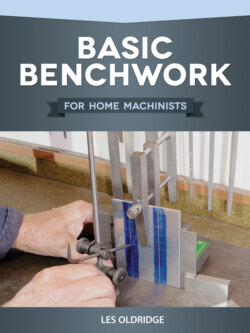Читать книгу Basic Benchwork for Home Machinists - Les Oldridge - Страница 10
На сайте Литреса книга снята с продажи.
Chapter 4 Hacksaws
ОглавлениеYou will often have to cut off a piece of metal to a prescribed length using a hacksaw. The hacksaw, then, is an essential tool in an engineer’s workshop, but it is often neglected, misused, or used with a blade that is not correct for the particular job in hand.
Hacksaw blades are classified by their degree of flexibility and how many teeth they have to the inch. High speed steel “all hard” blades are designed to give the optimum cutting performance on all types of materials but they are easily broken if misused. A famous maker describes them as the professional blade suitable for the man who takes a pride in his work and knows exactly how to use them. They can only be used where the workpiece is firmly held.
Probably more suitable for the model engineer is the bi-metal high speed blade, which consists of a high speed cutting edge electron beam welded to a tough alloy back. The makers claim that this blade is virtually unbreakable in normal use and is, therefore, safe in less experienced hands.
There are also flexible blades particularly suitable for work by trainees and occasional use by unskilled workers.
The number of teeth per inch on blades varies from fourteen to thirty-two. The expense involved will preclude the model engineer from stocking the whole range, and some with eighteen and some with twenty-four teeth per inch will probably meet most of his needs.
The number of teeth on the blade to be used depends on the material to be cut and its thickness. As a general rule, three consecutive teeth must be in contact with material being cut. If thin tubing or sheet has to be cut, then a blade with thirty-two teeth per inch is desirable.
The blade must be fitted to the frame with the teeth pointing forward, that is, away from the handle, see Fig. 4.1. The tensioning wing nut must be turned to take up the “slack,” and then tightened three full turns. Correct tension of the blade is important. If the blade is loose, it will buckle and not cut straight; if it is too tight, an unnecessary load is placed on the blade ends and damage to the blade or the frame may result.
Fig. 4.1 Teeth must point forward, away from handle.
Fig. 4.2 Cut should be started with as many teeth as possible in contact.
The metal to be cut must be securely fastened in the vise. When starting, the cut the thumb of the left hand can act as a guide to position the blade, using very short strokes with light pressure being applied. Do not start the cut on the short edge of the workpiece, but allow as many teeth as possible to be in contact with the work. Fig. 4.2 shows the right and wrong way to start a cut on a piece of angle iron. The wrong method might result in stripped teeth. When the blade has entered the work, the left hand is transferred to the front of the frame and long, steady strokes applied.
Fig. 4.3 and Fig. 4.4 show the incorrect and correct methods of holding work in the vise so that as many teeth as possible are in contact with the work.
Sixty strokes a minute is the correct speed for low speed alloy blades and seventy for high speed ones. Nothing is gained by increasing the speed: strokes using the full length of the blade give the best results and are less tiring. The beginner is very inclined to saw much too fast.
A new blade should not be used in a cut previously made by a worn one, as the old cut will be narrower than the one that the new blade will cut. If a new blade is used in the existing cut, it will jam and could easily break. If a blade breaks partly through a cut, the work should be turned over and the cut started from the other side.
Care is necessary when the saw reaches the end of its cut. Pressure and the rate of stroke should be reduced. Neglecting this precaution can result in injury to the hands and a broken blade.
Keeping a cut straight will come with practice; not too much pressure, a correctly tensioned blade and long, steady strokes all make for accurate work. Cutting carefully to a scribed line will save a lot of tedious filing necessary to bring a job to the prescribed dimension, and to correct the error made in the sawing.
Fig. 4.3 INCORRECT. Work held in vise so that narrow side is in contact with the hacksaw teeth.
Hacksaw blades can be obtained in several different lengths and a 12 in. blade is recommended for general use. Hacksaw frames are generally adjustable to allow different length blades to be used.
Junior hacksaws, a small edition of the one already described, are often used by the model engineer for small, delicate jobs. Light and easy to handle, they form a useful addition to the tool kit.
As is common with all types of saws, the teeth of hacksaws are set to the sides. This causes the blade to cut a slot wider than itself, and prevents the body of the blade rubbing or jamming in the saw cut. Often, alternate teeth are set to right and left, every third or fifth tooth being left straight to break up the chips and help the teeth to clear themselves.
Fig. 4.4 CORRECT. Wide side of work presented to the hacksaw teeth.
